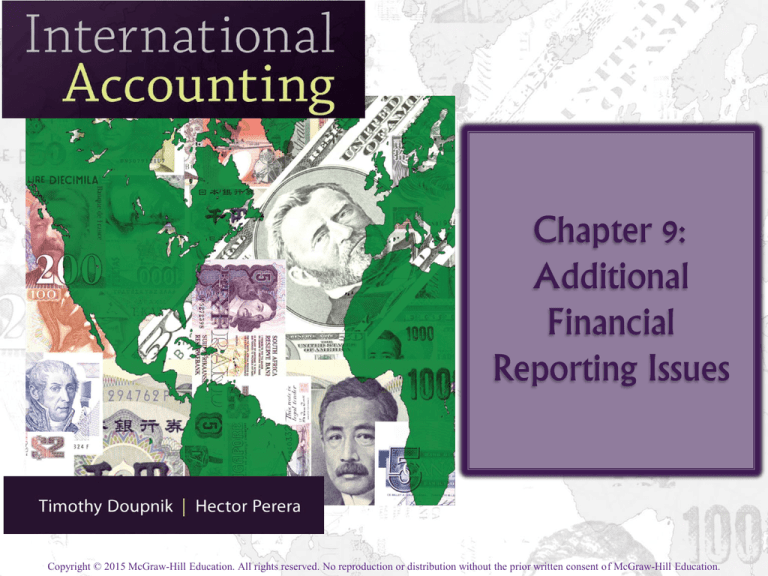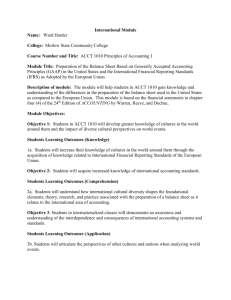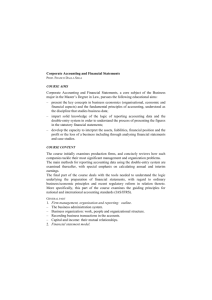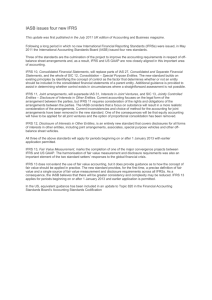
Chapter 9:
Additional
Financial
Reporting Issues
Copyright © 2015 McGraw-Hill Education. All rights reserved. No reproduction or distribution without the prior written consent of McGraw-Hill Education.
Learning Objectives
Explain the concepts underlying two methods of
accounting for changing prices (inflation)—general
purchasing power accounting and current cost accounting
Describe attempts to account for inflation in different
countries, as well as the rules found in International
Financial Reporting Standards (IFRS) related to this issue
Discuss the various issues related to the accounting for
business combinations and the preparation of consolidated
financial statements (group accounting)
Present the approaches used internationally to address
the issues related to group accounting, focusing on IFRS
Describe IFRS segment reporting requirements
9-2
Inflation Accounting – Impact on financial
statements
Impact of inflation on financial statements
Understated asset values
Overstated income and overpayment of taxes
Differing rate of inflation
Differing impacts across companies
Lack of comparability
9-3
Purchasing Power Gains and Losses
Historical cost ignores
Purchasing power gains and losses
During inflation
Holding cash and receivables
Purchasing power losses
Holding monetary liabilities
Purchasing power gains
Two approaches to inflation accounting
General purchasing power accounting
Current cost accounting
9-4
Approaches to inflation accounting
General purchasing power
Adjusts historical costs of assets
Updates currency purchasing power changes
Referred as
General price-level-adjusted historical cost (GPLAHC)
accounting
Purchasing power gains and losses included in net
income
9-5
Approaches to inflation accounting
Current cost accounting
Accounts specific price changes
Updates assets value
From historical cost to the current cost
Referred as
Current Replacement Cost Accounting (CRC)
Nonmonetary assets restated
To current replacement costs
Expense items based on restated costs
Holding gains and losses included in equity
9-6
Inflation Accounting Internationally
United States
In 1979, (FASB)
SFAS 33, Financial Reporting and Changing Prices
Required large U.S. companies
Provide GPP and CC accounting disclosures
In 1984, (FASB)
Discontinued supplemental GPP information
Two years later
Information is optional (SFAS 89)
Few companies provide
Since the 1980s
Experienced low rates of inflation
Inflation accounting lifted
9-7
Inflation Accounting Internationally
United Kingdom
Introduced in 1980
Statement of Standard Accounting Practice (SSAP) 16
Required current cost information
Rescinded
Since the 1980s
Experienced low rates of inflation
Inflation accounting lifted
9-8
Inflation Accounting Internationally
Latin America
Long history of inflation
Brazil, Chile, and Mexico
Sophisticated standards
Brazil abandoned
9-9
Inflation Accounting Internationally
Mexico – Bulletin B-10
Restatement of nonmonetary assets and liabilities
Central bank’s general price level index
Exception
Option to use replacement cost
For inventory and related cost of goods sold
Imported machinery and equipment
Combination of
Country of origin price index
Exchange rate between Mexico and country of origin
Bulletin B-10 abandoned in 2007
9-10
Inflation Accounting Internationally
Netherlands – Replacement Cost Accounting
Allowed companies to use replacement cost accounting
In 2005, IFRS introduced in Europe
9-11
Inflation Accounting Internationally
International Financial Reporting Standards
IAS 15, Information Reflecting the Effects of Changing
Prices
Issued in 1981
Standard withdrawn
Lack of support
Relevant standard now
IAS 29, Financial Reporting in Hyperinflationary
Economies
IAS 29 required by companies
Located in highly inflationary environments
IAS 21, The effects of Changes in Foreign Exchange Rates
Requires restatement of foreign operations
Located in highly inflationary environments
9-12
Inflation Accounting Internationally
International Financial Reporting Standards
IAS 29 – determines the environments
Restatement using a general price index
Nonmonetary assets
Nonmonetary liabilities
Stockholders’ equity
Income statement items from the time of the transaction
Purchasing power gains and losses
Included in net income
Comparative Information
Restated previous period information
Adjusted for change in general price index
9-13
Business Combinations and Consolidated
Financial Statements
Business Combinations is
Acquisition of one business by another
Referred as
Mergers and acquisitions activity
Primary expansion mechanism of MNCs
Different ways
Acquired company
Ceases to exist
Merged into acquiring company
Merging companies
Legally dissolve
New company formed
Group accounting
Accounting for
The parent
One or more subsidiaries
9-14
Business Combinations and Consolidated
Financial Statements
Determination of control
Legal control
Ownership of more than 50 percent
Shares and voting rights
Contract
Two companies
Legal control of one by other company
Effective control
Widely distributed stock ownership
Representation on the board of directors
9-15
Business Combinations and Consolidated
Financial Statements
Scope of Consolidation
IAS 27, Consolidated and Separate Financial
Statements
Requires consolidation
Parent and subsidiaries
No consolidation
Subsidiary intended to be disposed in 12 months
Management seeking a buyer
Subsidiary is dormant
Insignificant operations
U.S. GAAP
Exclusion of subsidiary not allowed
Although subsidiary held for sale
9-16
Business Combinations and Consolidated
Financial Statements
Full consolidation
Minority interest
Purchase method or
Pooling of interests method
IFRS 3, issued in 2004,
A separate item
Subsidiary not 100 percent owned
The non-owned portion
Methods
Subsidiary’s financial statement
Line-by-line aggregation
100% of the elements
Purchase method only
Pooling of interests is no longer acceptable under IFRS, or
in the U.S., Canada, Brazil or Mexico
9-17
Business Combinations and Consolidated
Financial Statements
Full Consolidation – Purchase Method
Acquisition of majority of voting shares
Assets and liabilities revalued
Fair value used for revaluation
Goodwill
Purchase price minus fair value
IFRS 3, Business Combinations
Purchase method referred as acquisition method
9-18
Business Combinations and Consolidated
Financial Statements
Full Consolidation – Goodwill
Accounting for goodwill
Significant variation internationally
U.S., IFRS, and most other countries
Goodwill capitalized
Amortization
Over five to 40 years
IFRS 3
Prohibits amortization over useful life
Require annual impairment test
Japan allows immediate expensing of goodwill
9-19
Business Combinations and Consolidated
Financial Statements
Project for Convergence of U.S. GAAP and IFRS
IFRS 3, Business Combinations
SFAS 141(R), Business Combinations
Unifies M&A accounting across capital markets
Removal from IFRS
Accounting of step and partial acquisitions
Goodwill measured as
On acquisition date
Difference in
Value of investment held plus consideration
Net asset acquired
9-20
Business Combinations and Consolidated
Financial Statements
Group Accounting – Equity Method
The equity method is used by investors that
Do not control
Have significant influence over an investee
20% or more ownership of the voting shares
One-line consolidation
Relevant standards
IAS 28, Investment in Associates and Joint Ventures
IFRS 11, Joint Arrangements
9-21
Segment Reporting
Facilitates
In November 2006
Analysis
Evaluation of financial statements
IASB issued IFRS 8, Operating Segments
Converges IFRS with U.S. GAAP
IASB adopted
Management approach
Segments defined by
Line-of-business
Geographic area
9-22
Segment Reporting
An operating segment
Earns revenues and incurs expenses
Operating results reviewed for
Discrete financial information available
Performance
Resource allocation
Significant if
Meets revenue test
Meets profit and loss test
Meets asset test
9-23
Segment Reporting
Differences between IFRS 8 and U.S. GAAP
U.S. GAAP– no disclosure of segment liabilities
IFRS 8–intangibles included in
Long-lived assets
For geographic area disclosures
Basis of operating segments
IFRS 8 allows
Products or services or geographic areas
U.S. GAAP allows
Products or services basis
9-24
Segment Reporting—Disclosures
General information
Segment profit or loss and the following line items:
Revenues from external customers
Intersegment revenues
Interest revenue and expense
Depreciation, depletion and amortization
Significant noncash items in segment profit or loss
Unusual items (e.g. discontinued operations and
extraordinary items)
Income tax expense or benefit
9-25
Segment Reporting—Disclosures
Total segment assets (and liabilities for IFRS)
Investment in equity method affiliates
Expenditures for additions to
Long-lived assets (U.S. GAAP)
Noncurrent assets (IFRS 8)
9-26
Entity Reporting—IFRS and U.S. GAAP
IFRS and U.S. GAAP require
Entity-Wide Disclosures about
Products and services
Major customers (if 10% or more of total entity revenue)
Geographic areas
9-27
End of Chapter 9
9-28





